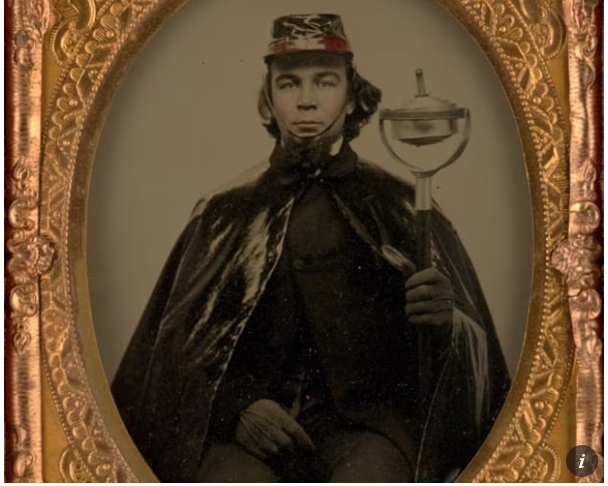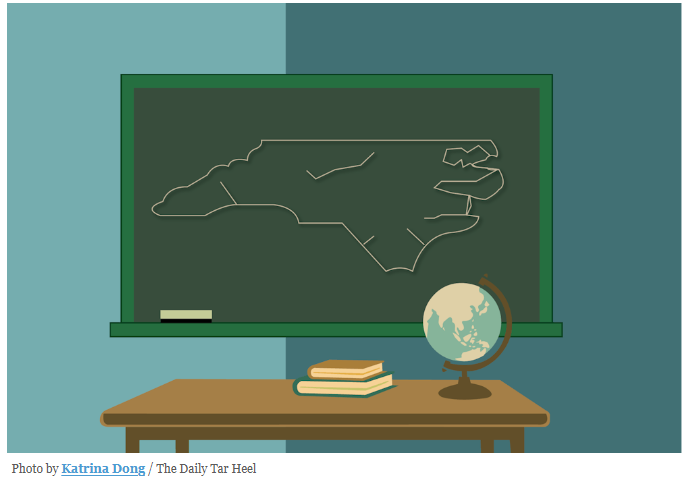History is really the only thing I can do,” Jon Grinspan says, smiling. “I worked in restaurant kitchens, I did other things, but really history is it. If I ever have to stop, I don’t know what I could do. It’s like I’m a one-use tool.”
He’s being modest. But he definitely does history. A Philadelphia native who studied at Sarah Lawrence in New York and got his PhD from the University of Virginia, Grinspan is now a curator of political history at the National Museum of American History in Washington DC.
He’s also the author of a new book, Wide Awake: The Forgotten Force That Elected Lincoln and Spurred the Civil War, which casts a bright torchlight on to a fascinating if brief episode in 1860s America with strong echoes in the divided nation of today.
The Wide Awakes were a political movement, begun in Hartford, Connecticut, around the elections of 1860, growing spontaneously and nationally as a way for young men to publicly support Republican anti-slavery candidates, most prominently Abraham Lincoln. Members wore capes, often bearing a painted eye, carried flaming torches and wore military hats and approximations of uniform as they marched in opposition to the slave-holding south.
In his small Smithsonian office, after a trip to the museum stores to see a Wide Awake torch, the last coffee cup used by Abraham Lincoln and other precious relics, Grinspan describes how he found his way to the Wide Awakes.
“I always looked down on the civil war as a teenager, because it seemed so cookie-cutter and kind of hokey, very un-human and dry. And then in college we started reading Eric Foner” – the dean of civil war-era scholars – “and he made the factions in 19th-century America look human, kind of tribal. I got into it from there.”
As a curator, Grinspan is responsible for telling the story of US democracy – hence the giant cardboard pencil in the corner, emblazoned with the words “Write In Ralph Nader”. As it happens, the evocation of the third-party candidate who maybe cost Al Gore the presidency in 2000 points to one of Grinspan’s driving interests: turnout.
When he learned how many Americans voted in 19th-century elections, particularly around the civil war, “that made me want to find more. Turnout over 80%? What’s the story behind it? And that kind of guided me into trying to find the human stories, and from there it just seemed so exciting.

“Also, growing up in the 1990s and early 2000s, politics seemed so dry and tame in America. Turnout was lower in the 90s than at any time since the 1920s. So looking back to the 19th century, when democracy seems so much more vibrant and engaging and conflicted, I got into this world that was completely different. And then over the last 20 years, our world has come to look much more heated, for mostly negative reasons, so it feels like I got into something really niche that has become somehow relevant.”
‘Guys with torches in the night’
Grinspan found the Wide Awakes “at grad school, in need of an idea for my thesis. I got so into it I essentially bombed all my classes the first year. They threatened to throw me out, but I just felt the Wide Awake story wasn’t being told and I wanted to tell it.
“So I got pretty fixated on it and I submitted a piece to the Journal of American History. And then, right when I was on the cusp of being kicked out, the Journal said, ‘We’re gonna run this in our Lincoln Bicentennial, which is 2009.’ From there, I had some great professors who said, ‘Just be ruthless in doing the work you want to do.’ And, pat myself on the back, it turned into a career, right?”
Right. The Wide Awakes are known but they flourished briefly, before a civil war in which most were subsumed by the Union army. Grinspan has room to move.
“There’s a little scene in the preface of this book where a professor turns to his computer, goes on a newspaper database, plugs in ‘Wide Awake’ and gets 15,000 hits for 1860,” Grinspan says. “And yet the group had been so neglected.
“It usually gets a paragraph in good books on 1860. They’ll describe Wide Awake marches somewhere, maybe around the Chicago Republican convention in May. They’re outside. But then you’ll get 35 pages on the fight for the Republican nomination and you’ll get a biography of Edward Bates [Lincoln’s attorney general] at 15 pages. But you have this mass movement, hundreds of thousands of people? And I’m gonna get a paragraph?”
Grinspan thinks some neglect of the Wide Awakes comes from “a little bit of elitism”, history focused on great leaders. But “the Wide Awakes aren’t entirely a pretty story. And after the war, it’s much easier to valorise Lincoln than to focus on the guys with torches in the night.”

After the war, and Lincoln’s assassination, the Reconstruction years saw Ulysses S Grant, the general who became president, face down the Ku Klux Klan, torch-bearing night-raiders who terrorised Black people in the southern states.
But the Wide Awakes had a dark side of their own. Like the Republican party, they emerged from a primordial soup of anti-immigrant feeling.
“These white Anglo-Saxon Protestant Republicans were pretty hostile to the Irish Democrats and specifically Catholics,” Grinspan says. “The Wide Awakes in the 1850s are a nativist club. They are in nativist fights in Brooklyn, in Boston. You see accounts from Irish immigrants saying, ‘We stayed away from that group over there wearing the white hats.’ Because a ‘wide awake’ hat was the symbol of the group. And then the Wide Awakes in 1860, they take the same name just four or five years later. If you had started a movement called the Tea Party in 2015, people would have had associations. It’s a lot of the same people. They’re cheered on by the same newspapers like the Hartford Courant, which is massively anti-Irish.
“But they grow out of it. I think they find a better conspiracy to fight.”
By 1860, the southern grip on Washington was strong. The slave-owning states resisted change through an unrepresentative Congress and a supreme court tilted their way. The parallels with Washington today are strong, though labels have changed and it is Republicans who now pursue minority rule.
“You look at the behavior of the slave-owning elites and they are doing everything they can to control Congress and control the supreme court, to determine the future of the nation,” Grinspan says. “It’s kind of funny that we hate conspiracy theories, but every once in a while one is accurate.”
Another feature of Grinspan’s book that echoes strongly today concerns southern reactions to the Wide Awakes, which ranged from dismissive to angry to frightened. Particularly scarifying was the presence – remarkable enough in the segregated north – of Black men among the torch-bearing marchers.
“John Mercer Langston was as far as I know the first Black Wide Awake. He starts the club in Oberlin, Ohio, then later becomes a Reconstruction congressman, a really prominent figure. I knew when I started work on the Wide Awakes there were Black men involved, but I didn’t realise how compelling this story was.
“A lot were fugitives from slavery. They connect the dots to underground abolitionists in Boston, who were fighting slave catchers in the 1850s. They come out publicly with the Wide Awakes, marching in uniform, 144 African Americans with 10,000 white Wide Awakes. They’re not just claiming public space or claiming partisan identity: they’re in military uniforms, a tiny minority in a sea of white people. It’s a bold move.
“And those same guys, when the war breaks out, they organise the home guard and then they organise the 54th Massachusetts Regiment, the most prominent African American fighting force in the war. I see the Wide Awakes at a turning point there.
“And in the south and the Democratic north, people go crazy when they learn about Black Wide Awakes. They start posting disinformation broadsides for Black Wide Awake events, real events in Pittsburgh and Chicago where we know there were no African Americans, just to gin up anger and get people to vote Democratic.”
It all sounds familiar, evocative of rightwing fear and anger in summer 2020, when protests for racial justice spread and Trumpists insisted shadowy, black-clad anti-fascists, “Antifa”, threatened chaos and bloodshed.
Rightly, Grinspan is wary of pat journalistic comparisons. Generously, he says the Wide Awakes were alarming to many.
“After the 1850s, when there’s so much chaos in America, so much street fighting and Bleeding Kansas and the Know Nothing gangs, people marching in order, in silence, sends a political message. It’s saying, ‘We actually are the people in this republic right now who can organise things. The Democrats can’t even stay together as a party and we have matching uniforms.’ They’re not armed but it’s not a big jump from torches to muskets, as they always say.”

Lincoln’s victory in 1860 was followed by civil war but it also caused the Wide Awakes to fade from the scene. Members wanted to escort the new president to Washington but despite knowing of threats to his life, Lincoln turned down the offer.
“If he brings a bodyguard to Washington,” Grinspan says, “if he has 5,000 or 100,000 Republicans in uniform come with him, he drives away Democrats, he drives away Kentucky, Maryland, Missouri, slave-owning border states.”
Prompted, Grinspan makes an apt comparison.
“I mean, January 6, you can see how you can rile up your supporters,” he says, of the day in 2021 when Donald Trump sent supporters, most in what passed for Maga uniform, some in tactical gear, to attack Congress itself.
“When Mussolini marches on Rome, he brings his blackshirts with him. There are so many examples of a leader mobilising people this way. And Lincoln has the self-restraint not to do that. He puts it out through John Hay, his young secretary, to the young Wide Awakes in Springfield, Illinois: ‘Go to Washington as individuals. Don’t come as a company. If you want to come to the inauguration, that’s fine.’
“But there are still secret Wide Awakes in the crowd and they have the uniforms on.”
‘People keep finding objects’
Grinspan has ideas for his next book – which will be his fourth – and will continue to engage the public at the Smithsonian. Nonetheless, the publication of Wide Awake is a culmination, of sorts, of 17 years of consuming work.
“At first I felt I discovered something no one else knew about,” he says. “And then I thought, ‘I’m done.’ But people kept coming to me with more Wide Awakes stuff. I wouldn’t have written this book five or 10 years ago but people keep finding objects. I still find references in diaries I read. And there was a sort of neo-Wide Awake movement in 2020,” around protests for racial justice.
It seems Grinspan will never truly let go of the Wide Awakes. They’re part of his job, after all. Downstairs, in the conservation department, we approach another relic, spread out to be viewed with care.

It is a Wide Awake cape, owned and used by George P Holt of New Hampshire then stored in an attic for 100 years or more. Originally bright white with violet lettering, it has faded and frayed with time. But the painted eye, arranged to stare from the wearer’s breast, is as piercing as on the day it was made.
–theguardian.com



